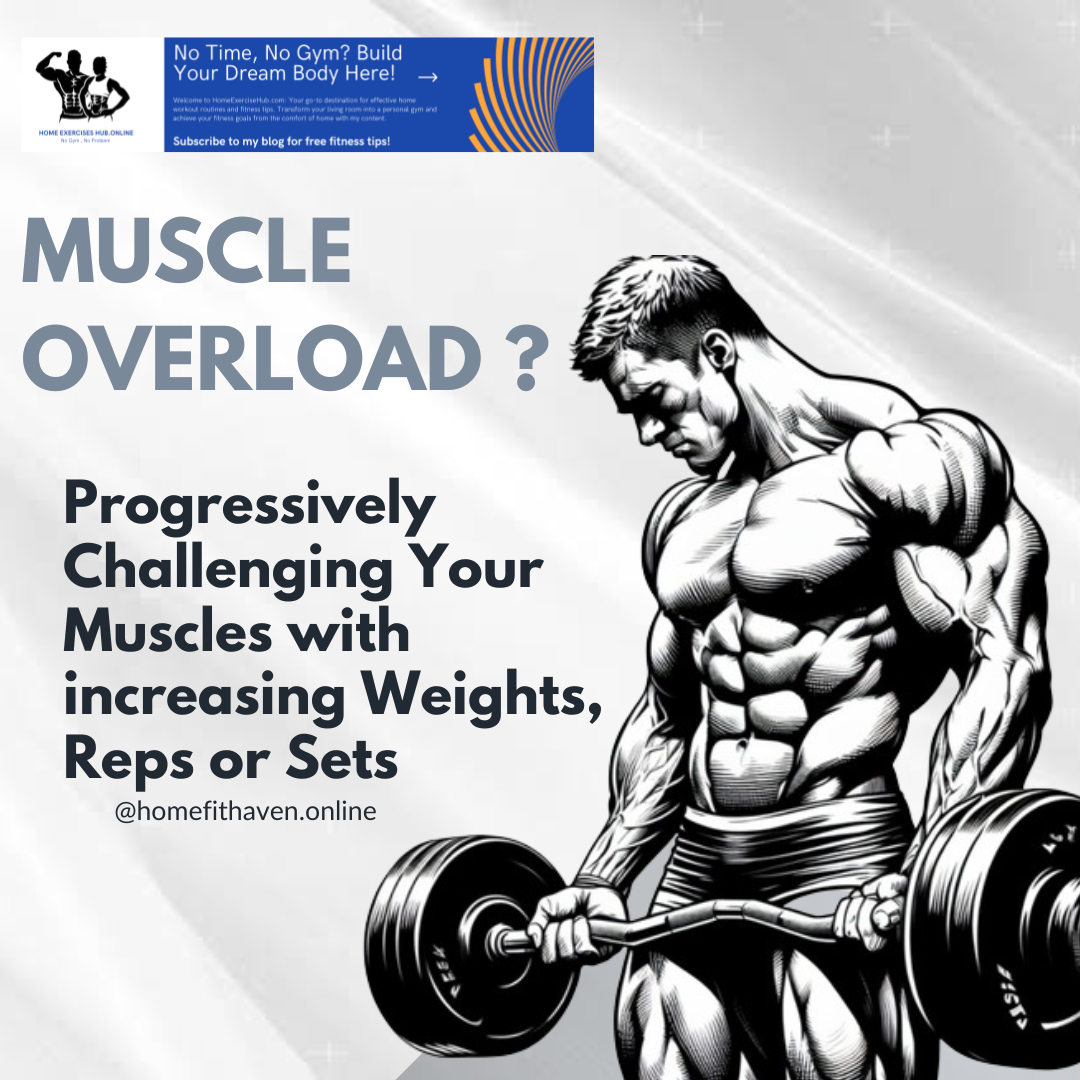Hidden Dangers of Amphetamines for Pre-Workout
Facial Exercises to Lose Face Fat
Building muscle isn't just about lifting weights. It's about challenging your muscles to adapt and get stronger. This is where the concept of muscle overload comes in.
So, if you're ready to push past plateaus and unlock your muscle-building potential, go ahead! This guide will explore the world of muscle overload, explain what it is, why it's important, and how to implement it safely and effectively in your workouts.
What is Muscle Overload?
Imagine your muscles are like mini factories. They constantly break down and rebuild themselves. When you exercise, especially with weights, you create microscopic tears in your muscle fibers. This error is a good thing! This signals your body to go to work, repairing and rebuilding those torn fibers. This repair process leads to stronger, thicker muscle fibers – that's muscle growth!
Here comes muscle overload. It's the concept of slowly putting pressure on your muscles that they're used to. This increased stress triggers a more critical repair response, causing more muscle growth than you would if you were maintaining your normal routine.
Why is Muscle Overload Important for Growth?
Think of it this way: if you always lift the same weight, your muscles eventually get used to it. They adapt and become strong enough to handle this weight without much struggle. This is where plateaus come in – your growth stalls. Muscle overload helps break this cycle. By progressively challenging your muscles with increasing weights, reps or sets, you force them to adapt and become stronger to meet the new demands.
Benefits of Muscle Overload:
- Increasing muscle mass: This is the ultimate goal for many people! Muscle overload stimulates growth, leading to a more sculpted and defined body.
- Improved strength: Strong muscles not only look good, but they improve your functional strength for everyday activities and athletic performance.
- Improved metabolism: Muscle tissue burns more calories at rest than fat tissue. Building muscle through overload can increase your metabolism, helping with weight management.
- Stronger bones: Increasing muscle mass puts more stress on your bones, causing them to adapt and become denser. This can help reduce the risk of osteoporosis.
Implementing Muscle Overload Safely and Effectively
Now for the interesting part – how to put this muscle building principle into practice! Here are some key strategies to consider:
- Progressive Overload: This is the basic principle. Gradually increase the weight you lift, the number of repetitions (repetitions) you perform, or the number of complete sets in your workout. Aim for small but steady increases over time.
- Focus on Form: Proper form is very important! Sacrificing form for heavier weights can lead to injuries and hinder progress.
- Rest and recovery: Your muscles need time to repair and rebuild. Aim for at least 48 hours of rest between workouts for the same muscle group.
- Train different muscle groups: Don't neglect different muscle groups! Add a variety of exercises to your routine to target different areas.
- Listen to your body: Don't push yourself to the point of pain. Take rest days when needed, and consult a health care professional if you experience any discomfort.
Muscle Overload in Action: Example Workout Routine
Let's look at how muscle overload can be implemented in a practical exercise routine. An example focusing on the chest and triceps is:
Week 1:
- Bench Press: 3 sets of 10 repetitions with a weight of 50 lbs
- Tricep Extensions: 3 sets of 12 repetitions with a 20-pound weight
Week 3:
- Bench press: 3 sets of 10 repetitions with a weight of 55 pounds (increased weight)
- Tricep Extensions: 3 sets of 12 repetitions with a 22.5 lb weight (increased weight)
Week 5:
- Bench press: 3 sets of 11 repetitions with a weight of 55 pounds (increased reps)
- Tricep Extensions: 3 sets of 13 repetitions with a 22.5-pound weight (extended rep)
Week 7:
- Bench press: 4 sets of 10 repetitions with a weight of 55 pounds (extended set)
- Tricep extension: 4 sets of 12 repetitions with a weight of 22.5 pounds (extended set)
Beyond the Basics: Advanced Muscle Overload Techniques
Once you've mastered the basics, you can explore advanced techniques to further challenge your muscles. Here are some examples:
- Drop Sets: Gradually decrease the weight during a single set and maintain the same number of reps. It helps push your muscles towards fatigue despite the light weight.
- Supersets: Pair two exercises to oppose back-to-back muscle groups with minimal rest. It keeps your heart rate up and speeds up the workout. (Find examples of supersets at HomeFithaven.online!)
- Rest Interval Sets: When you reach instantaneous failure, pause briefly (3-5 seconds) mid-rep. This allows you to squeeze in a few more reps with good form, maximizing muscle engagement.
Remember, these advanced techniques are for experienced lifters. Always prioritize proper form and listen to your body before trying.
Muscle Overload: It's Not Just About Lifting Heavier
Although weight gain is a common method for muscle overload, it is not the only one. Here are some alternative ways to overload your muscles:
- Increase time under tension (TUT): Focus on slowing down the movement during both the lifting and lowering phases of the exercise. This increases the amount of time your muscles are under tension, which leads to greater growth.
- Vary Your Rep Range: Experiment with different rep ranges. High reps (15-20+) can promote muscle endurance and growth, while low reps (6-8) can build strength and power.
- Add unilateral exercises: Exercises that work one side of your body at a time, such as single-leg squats or dumbbell rows, can challenge your stabilizer muscles and lead to overall development.
- Shorten Rest Periods: As you get stronger, consider shortening your rest periods between sets (30-45 seconds). This keeps your heart rate up and increases the overall intensity of your workout.
Tracking Your Progress: Key to Success
To effectively implement muscle overload, tracking your progress is crucial. Here's how:
- Maintain a workout log: Note the weight, reps, sets and rest periods for each workout. It helps you track your progress and adjust your workout accordingly.
- Take progress photos: Take photos of yourself at regular intervals to visually see your muscle building journey. This can be a great motivator!
- Use fitness apps: Many fitness apps can track your workouts and provide valuable insights into your progress.
Building muscle takes time and dedication.
Don't expect overnight results. Muscle growth is a gradual process. Be patient, be consistent with your workouts, and trust the strength of muscle overload.
Remember, proper form, proper rest, and a balanced diet are all essential ingredients to a successful muscle building journey. Let's Start Together!
HomeFithaven.online: Your Muscle Building Companion
At HomeFithaven.online, we are passionate about helping you achieve your fitness goals. We offer many resources to guide you on your muscle building journey:
- Free Exercise Guides: Find a variety of exercise routines designed for different fitness levels, all incorporating the principles of muscle overload.
- Detailed Exercise Lessons: Learn proper form and explore exercise variations to maximize your workout and avoid injuries.
- Nutrition Guide: Discover the importance of nutrition for muscle growth and find tips for creating a balanced diet.
- Supportive Community: Connect with fellow fitness enthusiasts on our online forum and share your experiences, ask questions, and get inspired!
Embrace the challenge, unleash your potential.
Muscle overload is a powerful tool for unlocking your muscle-building potential. Implement the strategies outlined above, track your progress, and prioritize proper form and maintenance. With dedication and consistency, you can push past plateaus and build the strong, sculpted body you want.
So, are you ready to test muscle overload? Get ready to challenge yourself, break boundaries and achieve amazing results! Remember, HomeFithaven.online is here to support you every step of the way.
Let's start your muscle building journey today!









_20240219_133339_0000.png)

